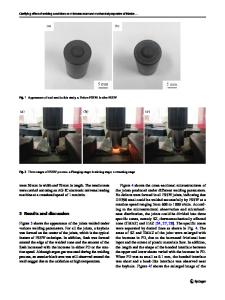Microstructures and Mechanical Properties of Steel/Aluminum Alloy Joints Welded by Resistance Spot Welding
- PDF / 3,597,802 Bytes
- 14 Pages / 593.972 x 792 pts Page_size
- 19 Downloads / 614 Views
JMEPEG DOI: 10.1007/s11665-017-2731-6
Microstructures and Mechanical Properties of Steel/ Aluminum Alloy Joints Welded by Resistance Spot Welding Yueying Zhang and Daqian Sun (Submitted April 26, 2016; in revised form March 26, 2017) The aim of this study was to investigate the effects of welding current and welding time on the microstructure and mechanical properties of welding joints. To this end, two dissimilar materials, austenitic stainless steel alloy SUS301L and aluminum alloy 6063-T6, were welded together via intermediate frequency resistance spot welding. A thick, two-layered intermetallic compound layer containing FeAl3 and Fe2Al5 phases was formed at the SUS301L/6063-T6 interface. As the welding current and welding time increased, the nugget diameter increased, the interfacial layer structure became coarser, the thickness of the interfacial intermetallic compound increased, and the tensile shear load of the weld joints had an increased welding tendency in stainless steel/aluminum joints. The nugget diameter reached 5.4 mm, and the maximum tensile shear load reached 1783 N at 7 kA for 200 ms of welding time. The resistance spot welded joint exhibited an interfacial fracture mode in the welded joint. The crack initiated at the interfacial intermetallic compound layer near the aluminum alloy side and spread through the interfacial layer, as well as through the aluminum alloy fusion zone near the interface. Keywords
aluminum alloy, austenitic stainless steel, dissimilar material joints, mechanical properties, microstructures, resistance spot welding, welding parameters
1. Introduction In recent years, energy shortages and environmental pollution have received increased attention for their urgency. Lowemission vehicles are being considered as a potential solution to these issues, owing to their numerous social and economic benefits. Accordingly, lightweight automotive technology has been a key area of development. Lightweight automotive technology is important for improving automobile fuel economy (Ref 1-3); a rule of thumb is that for every 10% in the weight reduction in a vehicle, its fuel consumption decreases by 3-5% (Ref 3). Aluminum alloys rank among the most useful engineering materials because of their favorable properties and low material costs (Ref 4, 5). The low density, high thermal conductivity, high strength, high corrosion resistance, good deformation rate, and recycling potential make aluminum alloys ideal lightweight materials for use in automobiles (Ref 6, 7). Recently, a hybrid structure of austenitic stainless steel and aluminum alloy has been designed with these performance and cost goals in mind. While merging steels and aluminum alloys is an indispensable approach to obtain lightweight materials (Ref 8), the joining of two kinds of materials is impeded by their divergent properties and melting temperatures. It is difficult to obtain a sound joint of steel and aluminum alloy Yueying Zhang and Daqian Sun, Key Laboratory of Automobile Materials, Ministry of Education, School of Materials
Data Loading...











